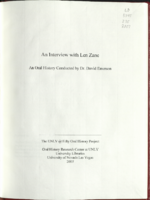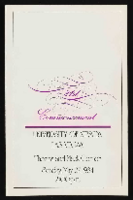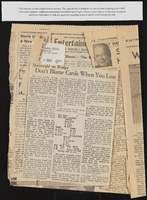Search the Special Collections and Archives Portal
Search Results

Transcript of interview with Len Zane by Dr. David Emerson, May 10, 2007
Date
Archival Collection
Description
Text

Transcript of interview with Sam Earl by Laura Button, March 9, 1981
Date
Archival Collection
Description
On March 9, 1981, Laura Button interviewed Sam Earl (born 1912 in Virgin, Utah) about his life in Nevada. Also present during the interview is Sam’s wife, Melissa Earl. The three discuss a wide range of topics from the early development of Las Vegas, Sam’s work on the Boulder Dam, the Earls’ early residence in a tent, and the family’s religious participation. The interview also covers gambling, Block 16, the first members of the police force, recreational activities, and the Helldorado parade. Sam also talks about his work as a building contractor, including some of the buildings and casino properties he helped build, and the interview moves to a discussion of the development of the Las Vegas Strip. The interview concludes with Sam’s description of his work as a truck driver and a discussion on welfare benefits.
Text

Interview with Oscar Foger, May 5, 2005
Date
Archival Collection
Description
Text

University of Nevada, Las Vegas (UNLV) 21st commencement program
Date
Archival Collection
Description
Commencement program from University of Nevada, Las Vegas Commencement Programs and Graduation Lists (UA-00115).
Text
Lamar and Patricia Marchese Papers
Identifier
Abstract
The Lamar and Patricia Marchese papers (1959-2015) contain awards, correspondence (both professional and personal), a Clark County Services and Facilities Directory, newspaper and magazine clippings, pamphlets, Parks and Recreation information, KNPR events and newsletters, art exhibits brochures, and musical performances brochures. The collection chronicles the contributions of the long-time Las Vegas community leaders through photographs, speeches, an interview done with Lamar Marchese, professional papers, audiovisual materials, Las Vegas Centennial Board (LVCB) end of year report, and a LVCB book.
Archival Collection

University of Nevada, Las Vegas (UNLV) Fall 2019 commencement program
Date
Archival Collection
Description
Commencement program from University of Nevada, Las Vegas Commencement Programs and Graduation Lists (UA-00115).
Text

Jose Leonardo Martinez oral history interview: transcript
Date
Archival Collection
Description
Oral history interview with Jose Leonardo Martinez conducted by Barbara Tabach and Nathalie Martinez on August 19 and 29, 2020 for the Latinx Voices of Southern Nevada Oral History Project. Session 1: Jose discusses his childhood and what it was like growing up during the Salvadoran Civil War. He recounts the dangers he's faced and how he made his way to the United States after traveling through Guatemala and Mexico. Subjects discussed include: Salvadoran Civil War; Ciudad Arce, El Salvador; Guatemala; Mexico; Los Angeles, California. Session 2: Jose continues his discussion of growing up in El Salvador and the violence he witnessed in the country's army during the 1980s. He also talks about his personal life after moving to the United States and his experiences navigating gang culture in Los Angeles, California. Jose recounts his previous jobs, his schooling, how he met his wife, and his family's move to Las Vegas. Subjects discussed include: El Salvador army; gang violence.
Text
Ronnow Family Photographs
Identifier
Abstract
The Ronnow Family Photographs contain four black-and-white photographic prints of the Ronnow family in Southern Nevada from approximately 1870 to 1950. Also included is one large oversized black-and-white photographic print of the Old Rotary Club with C. C. Ronnow present.
Archival Collection


